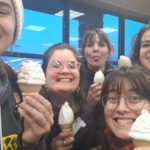By Sian Beck
How many of you have ever grown something? Maybe it was some tomatoes in your garden, some potted herbs on your kitchen window sill, or a succulent in your bedroom? And how many of you started with a seed? Has anyone ever saved a seed from that plant and planted it the next year?
These are the questions I generally start off my seed packing parties with, and I am continually amazed by the exposure some of the local youth have had to gardening, let alone seed saving. At each of the handful of seed packing parties I’ve facilitated, at least one student has experience seed saving.
Over the last couple of months, I’ve had the unique opportunity to work with middle and high school groups packing seeds for Free the Seeds!, a local event focused on building a resilient and sustainable food system. The first part of the event is a seed swap, where folks can donate and take home seeds that have been saved locally from plants. Throughout the day there are workshops surrounding building a local food system and giving the community skills and tools to become closer to the source of the food they eat.
Before diving in and packing seeds, I try and frame the activity with a purpose. The key question is why? Why would we would we want to save seeds? Without fail, someone hits the nail on the head. There are a few reasons; you can grow your own food for next to no cost, you can pick and choose the traits you want (size, flavor, color), it helps to provide genetic diversity, and it helps adapt the seeds to the local climate. It is exactly what people have been doing for hundreds of thousands of years to produce long, crunchy orange carrots instead of the woody white roots they used to be. There’s a sense of independence and satisfaction that is understandable at any age; it is rewarding and a practice that transcends generations.
Anyone who is familiar with my position would know that I typically spend my days sitting (or standing, thanks to my stand-up desk) at a desk working on Glacier National Park’s sustainability plan or other Green Team initiatives, not hanging out with youth or packing seeds. Over the five-week government shutdown, it quickly became clear that I would be falling behind on my service hours if I didn’t find a way to get hours in outside of my office. Links with Climate Smart Glacier Country lead me to this event and I couldn’t be happier to get out of the office and chatting with young folks about food and the environment. I also had the privilege of connecting with youth workers, food corps members, librarians, and educators throughout the Flathead Valley. Talking with them, I’ve come to understand the mixed relationships with food and the environment in the valley. While some kids have gardens at home and go hunting or fishing with their parents, some have no idea where baby carrots come from and live in homes where their parents don’t cook.
Food is important on so many levels, from connecting people to their communities and the earth to nourishing their bodies. While seed saving may not appear to be an innately environmental project, it has a plethora of positive impacts on the environment, namely removing any emissions from transportation and processing. Introducing the idea of seed adaptation and growing food for yourself does wonders and I am overjoyed to have gotten the opportunity to connect with the good work being done in the communities surrounding Glacier.








